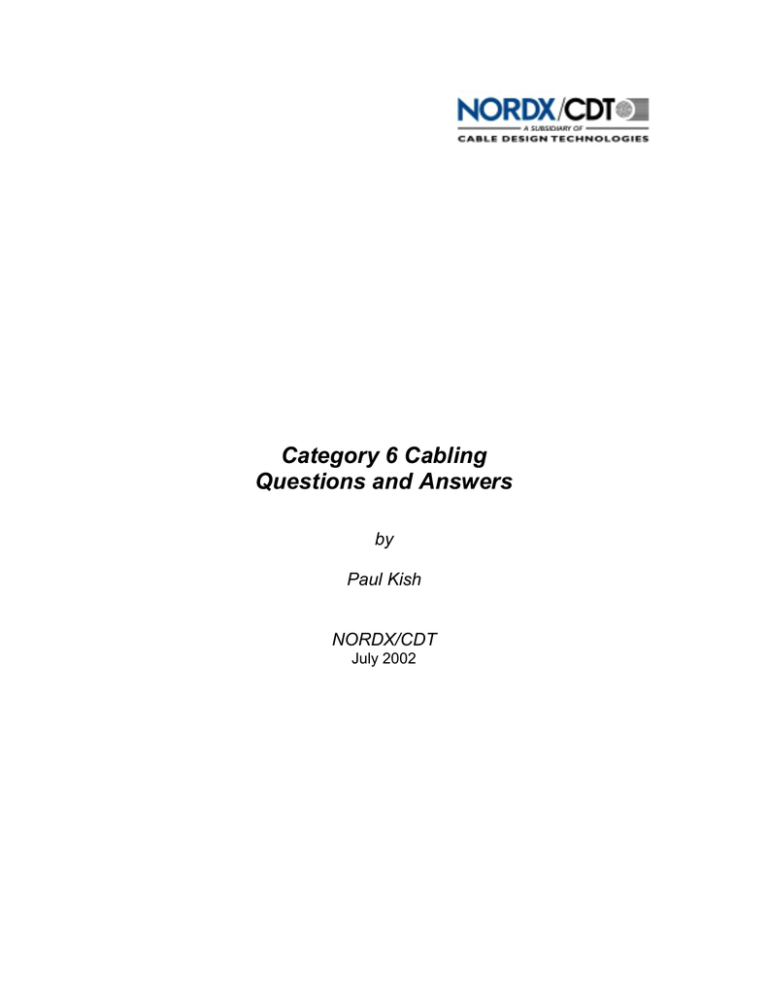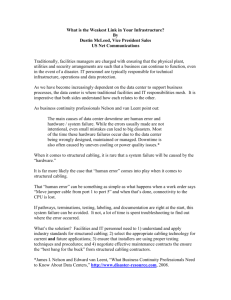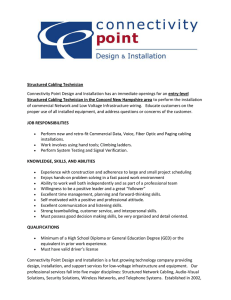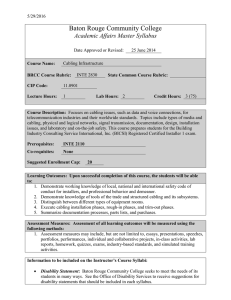
Category 6 Cabling
Questions and Answers
by
Paul Kish
NORDX/CDT
July 2002
Introduction
On June 20th, 2002, TIA finally published the Category 6 cabling standard. Now that this
standard is a reality, many people are exhibiting renewed interest and are asking themselves
- So what is Category 6 cabling? Does it look and behave differently than Category 5 / 5e? Will it
supercede Category 5 / 5e? Does it work? Have all the issues been resolved? What does it
mean for network performance? What are the applications that will work on Category 6 that don’t
work, or don’t work as well, on Category 5e cabling? These are very good questions, and this
paper will provide simple and impartial answers to these questions. For more information, a list of
references is provided that explains bandwidth, cabling parameters and cabling performance in
more detail.
What is Cat 6?
“If it looks like Category 6, and it feels like Category 6, and it sounds like Category 6, then it must
be Category 6! To feel comfortable with this argument, you need to know “What is Cat 6?” It is a
cabling system comprised of components (cables, cords and connecting hardware) that have
many features in common with Category 5 and 5e but also some significant differences. Let’s
look at some of these similarities and differences:
First of all, Category 6 components are specified to be interoperable between different vendor’s
products and are fully backward compatible with all lower categories. Interoperability means that
Category 6 components from different vendors can be mixed and matched to form a minimally
compliant Category 6 Channel. Backward compatibility means that a Category 6 component can
be substituted in any existing Category 5 or 5e channel to give Category 5 or 5e performance
respectively. Although being ‘backward compatible’ seems like an obvious feature, it is not quite
as easy as it sounds from the manufacturers’ point-of-view. Similarly, ‘interoperability’ seems
obvious in today’s world of ‘open architectures’, but this concept presented significant challenges
for both TIA and the manufacturers alike. Like most good things, these features were not easy to
create, but worth the benefits that they bring to the end-user community.
Second, all Category 6 components have the same nominal Impedance of 100 Ohms as
Category 5 and 5e components, but have a tighter tolerance on Impedance variations.
Impedance variations are specified in terms of a parameter called Return Loss. A higher value of
Return Loss (in dB) means better Impedance matching between components and lower signal
reflections and re-reflections. As a result, Category 6 provides better Bit Error Rate (BER)
performance for Fast Ethernet (100BASE-TX) and Gigabit Ethernet (1000BASE-T) networks.
More frequently occurring bit errors means that your expensive networking devices are caught in
unproductive cycles of error detection and re-transmission. Fewer bit errors means that your
network is accurately and rapidly transferring the information that drives your business and
improves productivity.
Third, all the transmission parameters for Category 6 channels, permanent links and components
are specified up to 250 MHz compared to 100 MHz for Category 5 and 5e. Annex A provides a
detailed comparison of the transmission performance of Category 6 and Category 5e channels as
specified in the published TIA standards.
There is a difference between the specified frequency range and the usable Bandwidth.
Bandwidth is defined as the frequency range where the PSACR (Power Sum Attenuation-toCrosstalk Ratio) is positive. Category 6 yields a Bandwidth* of 200 MHz at 20 °C for the most
demanding 100 meter channel configurations compared to a bandwidth of 100 MHz for Category
5 / 5e. So if you consider Bandwidth to be the ‘speedometer’ for cabling systems, you will see
that Category 6 effectively doubles the ‘top speed’ of earlier standards.
* Note: For more information see Category 6 Requirements at 200 Mhz and 250 MHz
2
Do Category 6 components behave differently than Category 5 / 5e?
One of the biggest observable differences is in the cable construction. From the outside,
Category 6 cables have a larger overall diameter, to a greater or lesser extent depending on the
design. The diameter of Category 6 cables are in the range of 0.21 to 0.25 inch (5.3 - 5.8 mm)
compared to Category 5/ 5e, which is in the range of 0.19 to 0.22 inch (4.8 – 5.5 mm). This is
because Category 6 cables are manufactured with larger copper conductors and may include an
internal divider called a cross-web that serves to separate the pairs within the cable and reduce
cross-talk noise. The cross-web divider to separate the pairs is not a specified requirement of the
Cat 6 standard, and some manufacturers have developed designs and processes that deliver full
Cat 6 compliance without the use of any physical dividers between pairs.
The reason for the larger conductor size (approx. 23 AWG) is to provide a lower Insertion Loss
(also called Attenuation) over the specified frequency range. A lower Insertion Loss means a
stronger signal at the Receiver compared with Category 5 / 5e. This improves the noise
immunity to external and internal noise sources. Additionally, cables with a lower Insertion Loss
can support longer distances or a higher temperature range for certain applications while
continuing to deliver full Cat 6 performance. Even if you’re not a cabling expert, most of us will
recognize that lower Insertion Loss is the functional equivalent of a strong signal, and we all know
that signal strength is the critical factor in overall network performance.
Another feature of Category 6 cables is a very tight twist length of 0.5 inches or less to reduce
crosstalk interference between pairs. Altogether, these differences are analogous to buying a
car. There are many different models to choose from that come in different sizes and shapes and
with different features and performance. Category 6 cabling, with its larger conductors, internal
dividers, and tighter twist lengths would be analogous to a high-end model delivering better
performance and more capacity.
What about installation?
Category 6 cables and components are installed very much the same way as their Category 5 /
5e counterparts. However there are some design and installation issues that the contractor and
the installer must pay greater attention to, including 1) the cable terminations and 2) the cable
pathway fill. The larger physical cable diameter needs to be taken into account when routing
cables at cross-connects and in provisioning cable pathways. When terminating Category 6
cables it is very important to ensure that the pair twists are maintained right up to the point of
termination. It is particularly important to follow manufacturer’s instructions for terminating
connectors. A poor termination can significantly reduce performance margins (Article:
"Category 6 Testing in the Field") or cause test failures in the field.
Will Category 6 supercede Category 5 / 5e?
The answer is yes; the only question is “When”? Today, the choice for Category 6 tends to be an
economic one. Like most newly introduced technologies, Category 6 systems currently
command a price premium and the installed cost for Category 6 cabling can be about 20 %
higher than Category 5e, depending on market conditions. Experience tells us that prices will
decrease over time as acceptance and volume increases. Regardless of traditional technology
life-cycle pricing, the benefits of Category 6 in terms of bandwidth, performance headroom,
reliability and application support, need to be weighed against end user needs, planning horizon
and budgetary constraints. From a cost/benefit perspective the doubling effect of Category 6
performance versus Category 5/5e performance for as little as a 20% pricing premium deserves
careful consideration. And the equation improves if you factor in the reality that the ‘technology
window’ and operational life span of Category 6 systems will far out reach Category5/5e systems.
3
So, even with a new technology, an old adage rings true; it may be ‘penny wise, but pound
foolish’ to implement new Category 5/5e systems today only to be forced to replace them in the
near future because continually evolving IT systems need Category 6 performance. To
paraphrase from a famous film that suggested “If you build it, they will come”, The Cat5/5e to Cat
6 migration would be better described as “If you don’t build it, they are coming anyway!” As we
see with all technologies, the needs for ‘more’ and ‘faster’ are inevitable and irresistible forces
that must be considered in your cabling infrastructure decisions.
Have all the bugs been ironed out, and does Category 6 deliver what is
promised?
The answer is ‘yes’. There are no technical obstacles in the way. What took so long in
completing the standard was the development of the test parameters and the test procedures that
are used to qualify Category 6 components to ensure interoperability between different vendor’s
products. These specifications are in place and very much detailed. Category 6 connecting
hardware needs to be qualified with a range of “high” and “low” test plugs that simulate worst
case variations in the field. This means that a specific connector design may work optimally with
certain plugs while only achieving minimum Cat 6 performance with other plugs. So while the
important concept of interoperability is delivered in the Cat 6 standard, it is most likely that
optimum performance would be achieved using connectors and cords from the same vendor.
A simple way to describe Category 6 connector performance is to think of a parameter called
sensitivity and selectivity on radio or TV receivers. Let’s take the example a Satellite Dish
Receiver. When the technician comes to install the satellite dish he points it in the general
direction of the satellite. While watching the signal level on the TV set or listening to an audible
beeper, the technician adjusts the dish up and down, left and right to get the strongest signal. It
is the same way with a plug / jack connection. There is a minimally acceptable signal level
depending on the orientation of the dish and an optimum signal when it is in the best alignment.
The Category 6 connector specification defines the deviation allowed and the minimum signal
level to achieve interoperability.
So, as you can see, Cat 6 does deliver on its promise. As a member of the TIA subcommittee
that developed Cat 6, NORDX/CDT had proposed that the ‘next generation’ cabling standard
should specify additional performance margins to account for ‘Alien Cross-talk’ and the effects of
temperature on cabling performance. Although consensus support for the NORDX/CDT proposal
was only partly accommodated, the work done by the Engineering Committee is a significant
accomplishment in the industry considering the level of detail, completeness and the quality of the
Category 6 standard as delivered. In retrospect, a curious fact comes to mind that is true for all
technology standards and perhaps especially true for cabling standards. New standards
represent significant new performance targets that we must stretch while under development. On
publication of the standard, these distant targets instantly transform from projected upper
thresholds to the absolute minimum acceptable performance values allowed under that standard.
While the Cat 6 might have gone further, the published standard provides a solid step forward
and our vision of higher performance systems will be achieved through a natural evolution in the
marketplace.
4
What about the performance of your network when Category 6 is installed
compared with Category 5 /5e?
Whether Cat 6 or Cat5/5e, network performance effectively boils down to Signal-to-Noise Ratio at
the Receiver. All the different noise sources need to be taken into account, including NEXT,
FEXT, ILD Noise, Alien Crosstalk and Impulse noise. The biggest benefit of Category 6 cabling is
the much-improved Signal-to-Noise Ratio (SNR) using the Bandwidth employed by today’s
applications and also for future applications. The main result is that Category 6 provides about 12
dB (or 16 times) better Signal-to-Noise Ratio compared to Category 5 / 5e over a wide frequency
range. For a more detailed technical explanation of this phenomenon, please refer to a white
paper on the subject entitled “Cat 6 vs. Cat 5 / 5e – How cabling parameters affect network
performance” Article: Cat 6 versus Cat5/5e
Why do we need Cat 6?
A frequently asked question is why do we need Category 6? Isn’t Category 5e good enough for
what is needed today and in the foreseeable future? The answer is “probably Yes”. Does that
mean we are avoiding the question. No, it simply means that we can only answer with certainty
for today, and can only postulate about the future. For today’s applications, there has been some
work done by others that indicates Category 6 provides higher Data Throughput (fewer bit errors)
than Category 5e for 100BASE-TX and 1000BASE-T applications. This work shows that some
network switch ports are at the limits of the IEEE 802.3ab standard (i.e. marginally compliant) and
are more susceptible to cabling and temperature variations. NORDX are presently in the process
of generating some information on the Data Throughput of Category 6 and Category 5e in the
presence of outside noise.
What about future applications?
A TIA Standard is already in place for Gigabit over Category 6 (1000BASE-TX) that provides for a
more cost-effective solution in the future. Another application that is quite demanding is
broadband video that today runs over coaxial cable. Broadband video can be supported over
Category 6 cabling at distances up to 100 meters and frequencies up to 550 MHz. Category 6 is
particularly suited for this application because of the lower signal losses and better transmission
performance at higher frequencies compared with Category 5 / 5e. Another application that is on
the horizon is digital video. The direct digital signals from HD-SDI sources are at 1.5 Gb/s, which
goes significantly beyond the capability of today’s twisted pair Cat 5 / 5e copper networks. An
analysis of the information capacity of Category 6 cabling with 200 MHz Bandwidth indicates that
it could support data rates of 2 Gb/s using the same encoding scheme of 1000BASE-T at twice
the clock rate.
Accepting that new installations should be better than Cat5e. Why not skip
Cat 6 and go all the way to optical fiber?
Without even considering the issue of relative performance, the copper/fiber decision has been
driven historically by the significant differences between the initial costs of copper versus fiber
cabling plants, combined with the even greater differences between the costs of electrical versus
optical networking devices. Overall, the comparatively high total cost of ownership for optical
networking made it very difficult to justify for use in horizontal distribution except where
environmental noise, or security, or ultra high performance requirements made copper solutions
impractical or inoperable. Today, the cost differential between copper and fiber cabling is
decreasing, however even as the cost of optical fiber becomes more comparable to copper, the
5
largest deterrent to the use of fiber continues to be the cost of the active optical networking
equipment.
To research information for this article, we ‘shopped’ equipment prices and availability on the
Internet. There are a plethora of choices that provide 100 Mb/s Fast Ethernet ports over copper
to the desktop and fewer choices over fiber. Looking at relative prices from a leading
manufacturer of networking equipment, a 48 port 100BASE-TX switch with two 1000BASE-X
uplinks is $4500US (approx. $80US / port for 100 Mb/s) compared with $4900 US for a 12-port
100BASE-FX switch (approx. $400US / port). In this particular example, the cost per user port for
the optical switch was more than 400% higher than its copper-based counterpart. Generally the
cost of optical networking equipment is from 2 to 4 times higher than copper. As an alternative
option, an end user can purchase a media converter with copper equipment. The added cost of
media converters for multimode fiber is about $112.00 US / port for Fast Ethernet and $385US /
port for Gigabit Ethernet (see reference: Frost & Sullivan), and some may be concerned over the
reliability/manageability issues that may arise from introducing additional points-of-failure in the
network. All this means that running fiber to the desk is not economically attractive for today’s
applications compared to copper, and the continually increasing performance envelop of copper
cabling systems would seem to be more than adequate for horizontal distribution now and in the
foreseeable future.
Another reason that supports high performance copper cabling to the desk is the need for remote
powering for VoIP telephones and other devices. This is an important new development. IEEE is
in the process of developing a DTE Powering standard that would enable end users to plug in a
variety of devices into the data outlet connector in the wall. The networking equipment or the
mid-span power source would detect and recognize the type of device, e.g. an IP phone, sensor,
camera, etc. and deliver the appropriate power as required by the device. This is an important
step towards a ubiquitous network that is designed for device independence. When powering
remote devices, Category 6 cabling has advantages over Category 5e because of the lower DC
resistance (23 AWG) and ‘Pair Balance’ recommendations, which is a new parameter for
Category 6 components.
Conclusions
This paper has explained the major differences and similarities between Category 6 and Category
5e cabling, and provides the reasons why an end user should consider Category 6 cabling for
new installations.
The new CAT 6 standard includes specific requirements for Interoperability between different
vendors’ products as well as full Backward Compatibility with all existing Category 5 / 5e cabling,
as this was a major objective in the development of the standard.
From a performance perspective, if we use Bandwidth and Signal-to-Noise Ratio (SNR) as the
key indicators of performance, Category 6 cabling provides twice the Bandwidth (200 MHz) and
16 times (12 dB) better than Signal-to-Noise margins compared with Category 5e cabling. These
additional performance margins compensate for deficiencies in the equipment and external noise
and temperature variations in the environment. Category 6 is well positioned to support
demanding applications such as multi-channel broadband video with an extended frequency
range up to 550 MHz and digital video signals as high as 2 Gb/s for HD-SDI and future multiGigabit applications. Category 6 cabling is also a better alternative to fiber-to-the-desk because
the cost of electronics is significantly lower for copper compared to fiber. Lastly, the new IEEE
standards for remote powering of DTE equipment would be better served with Category 6 cabling
because of the lower power dissipation for Category 6 cables and the improved balance
recommendations for Category 6 components.
6
All together, these performance improvements offered by Cat 6 systems means higher
capacity, throughput and productivity for your networks and your users. The forwardlooking Cat 6 specifications should produce an extended operational life span and
protection of your Cat 6 infrastructure investment. This combination of performance,
longevity, and investment protection, along with the new attributes of interoperability and
backward compatibility, makes Category 6 the smart choice for all new cabling system
implementations.
The authors:
Paul Kish is Director, IBDN Systems and Standards with NORDX/CDT. He is the
current vice-chair of the TIA TR-42 engineering committee responsible for
telecommunications cabling standards for commercial and residential installations.
References:
•
•
•
•
Category 6 Requirements at 200 Mhz and 250 MHz
Article: "Category 6 Testing in the Field"
Article: Cat 6 versus Cat5/5e
Frost & Sullivan, North American Premises Wiring Market, A040-62
www.frost.com
Special thanks to:
Warren Davies of NORDX/CDT for extensive comments and editorial review of this
document. His insight is very much appreciated.
7
Annex A
Category 6 Channel Transmission Performance
Frequency
MHz
1
4
8
10
16
20
25
31.25
62.5
100
200
250
Ins. Loss
Max (dB)
2.1
4
5.7
6.3
8
9
10.1
11.4
16.5
21.3
31.5
35.9
NEXT
Min (dB)
>65
63
58.2
56.6
53.2
51.6
50
48.4
43.4
39.9
34.8
33.1
ACR
Min (dB)
>62.9
59
52.5
50.3
45.2
42.6
39.9
37
26.9
18.6
3.3
-2.8
PSNEXT
Min (dB)
>62
60.5
55.6
54
50.6
49
47.3
45.7
40.6
37.1
31.9
30.2
PSACR
Min (dB)
>59.9
56.5
49.9
47.7
42.6
40
37.2
34.3
24.1
15.8
0.4
-5.7
ELFEXT PSELFEXT Return Loss Prop. Delay
Delay Skew
Min (dB)
Min (dB)
Min (dB)
Max (ns/100m) Max (ns/100m)
63.3
60.3
19
580
50
51.2
48.2
19
562
50
45.2
42.2
19
557
50
43.3
40.3
19
555
50
39.2
36.2
18
553
50
37.2
34.2
17.5
552
50
35.3
32.3
17
551
50
33.4
30.4
16.5
550
50
27.3
24.3
14
549
50
23.3
20.3
12
548
50
17.2
14.2
9
547
50
15.3
12.3
8
546
50
Category 5e Channel Transmission Performance
Frequency
MHz
1
4
8
10
16
20
25
31.25
62.5
100
Ins. Loss
Max (dB)
2.2
4.5
6.3
7.1
9.1
10.2
11.4
12.9
18.6
24
NEXT
Min (dB)
>60
53.5
48.6
47
43.6
42
40.3
38.7
33.6
30.1
ACR
Min (dB)
>57.8
49
42.3
39.9
34.5
31.8
28.9
25.8
15
6.1
PSNEXT
Min (dB)
>57
50.5
45.6
44
40.6
39
37.3
35.7
30.6
27.1
PSACR
Min (dB)
>54.8
46
39.3
36.9
31.5
28.8
25.9
22.8
12
3.1
ELFEXT PSELFEXT Return Loss Prop. Delay
Delay Skew
Min (dB)
Min (dB)
Min (dB)
Max (ns/100m) Max (ns/100m)
57.4
54.4
17
580
50
45.4
42.4
17
562
50
39.3
36.3
17
557
50
37.4
34.4
17
555
50
33.3
30.3
17
553
50
31.4
28.4
17
552
50
29.4
26.4
16
551
50
27.5
24.5
15.1
550
50
21.5
18.5
12.1
549
50
17.4
14.4
10
548
50
Difference in Channel Transmission Performance (Cat 6 vs. Cat 5e)
Frequency
MHz
1
4
8
10
16
20
25
31.25
62.5
100
Ins. Loss
Max (dB)
-0.1
-0.5
-0.6
-0.8
-1.1
-1.2
-1.3
-1.5
-2.1
-2.7
NEXT
Min (dB)
>5
9.5
9.6
9.6
9.6
9.6
9.7
9.7
9.8
9.8
ACR
Min (dB)
>5
10
10.2
10.4
10.7
10.8
11
11.2
11.9
12.5
PSNEXT
Min (dB)
>5
10
10
10
10
10
10
10
10
10
PSACR
Min (dB)
>5
10.5
10.6
10.8
11.1
11.2
11.3
11.5
12.1
12.7
ELFEXT PSELFEXT Return Loss Prop. Delay
Delay Skew
Min (dB)
Min (dB)
Min (dB)
Max (ns/100m) Max (ns/100m)
5.9
5.9
2
0
0
5.8
5.8
2
0
0
5.9
5.9
2
0
0
5.9
5.9
2
0
0
5.9
5.9
1
0
0
5.8
5.8
0.5
0
0
5.9
5.9
1
0
0
5.9
5.9
1.4
0
0
5.8
5.8
1.9
0
0
5.9
5.9
2
0
0
8
For further information, please visit our Web Site www.nordx.com,
or contact:
Caribbean and Latin America
NORDX/CDT, Inc.
11013 NW 30th Street
Miami, FL 33172
U.S.A.
Tel.: (305) 597-0262
Fax: (305) 597-0091
Tel. Jamaica: (800) 512-4008
Tel. Brazil: 000 815 8291 9928
Tel. Argentina: 54 11 4 311 4972
United States
NORDX/CDT Corp.
10 Mechanic St.
rd
3 Floor
Worcester, MA 01608
U.S.A.
Tel.: (800) 331-0779
Fax: (514) 822-7967
Canada
NORDX/CDT, Inc.
2345 Sources Blvd.
Pointe-Claire, QC H9R 5Z3
Canada
Tel.: (800) 681-6131
Fax: (514) 822-7968
Asia Pacific
NORDX/CDT
Asia Limited
7/F, Henan Building
90 Jaffe Road
Wanchai
Hong Kong
Tel.: (852) 2955-0128
Fax: (852) 2955-0001
Europe, Middle East
and Africa
NORDX/CDT Limited
NORDX House
Unit 4,The Western Centre
Western Road, Bracknell
Berkshire, RG12 1RW
United Kingdom
Tel.: (+44) 1344 661200
Fax: (+44) 1344 661201
Australia
NORDX/CDT
3 Harper Street
Abbotsford, Victoria
Australia
Tel.: 61-2-9945-0418
Fax: 61-2-9945-0419
Mexico
NORDX/CDT, Inc.
Ave. Insurgentes Sur,
N° 1457, Piso 11
Col Insurgentes Mixcoac,
C.P. 03920
Mexico, D.F. (Mexico City)
Tel.: 525-563-1617
Fax: 525-563-2515
3067
“All information is subject to change without
notice, since NORDX/CDT reserves the right
to change its products as progress in
engineering or manufacturing methods or
other circumstances may warrant.”
IBDN is a trademark of NORDX/CDT. All
trademarks are the property of their
respective owners.
© 2002 NORDX/CDT, Inc. All rights reserved
9





